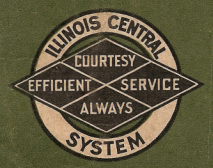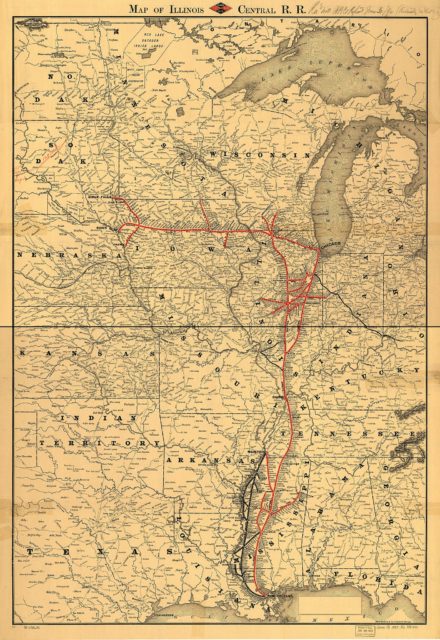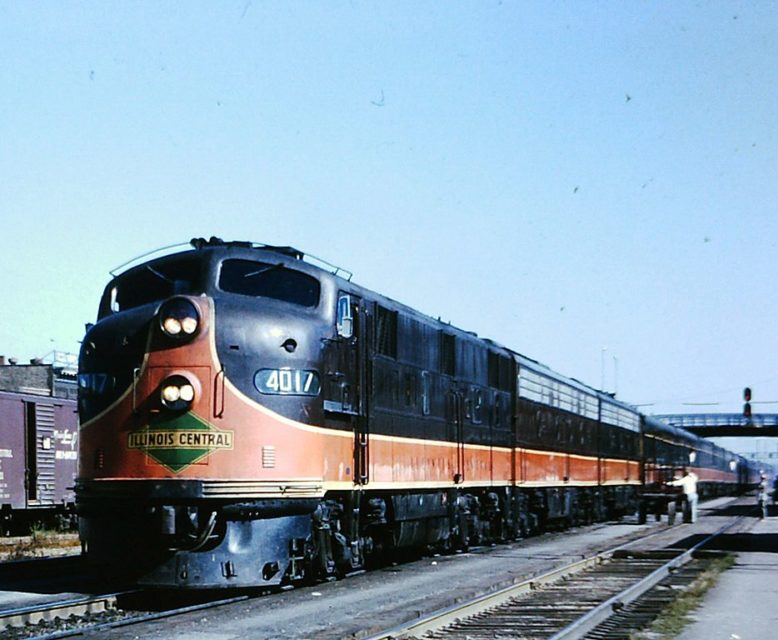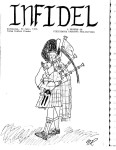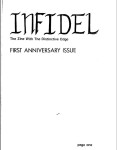Forgotten Weapons
Published Sep 6, 2015Have you heard of Jonathan Browning, gunsmith and inventor? Among his other accomplishments, he is credited with designing the harmonica rifle in the US — and we have an example of one of his hand-made guns here to look at today (made in 1853). Browning was a Mormon, and spent several years slowly moving west periodically setting up gunsmithing shops before he reached his final destination of Ogden, Utah. There he settled down for good, and had 22 children with his 3 wives. One of those children also showed an aptitude for gunsmithing, and formally apprenticed to his father. You might recognize his name …
February 2, 2024
J.M. Browning Harmonica Rifle
January 14, 2023
Colonial History on the Mississippi River
Scenic Routes to the Past
Published 13 Jan 2023This video explores the surprising traces of French and American colonial history along the 150 miles of Mississippi River between St. Louis and Cairo, Illinois.
(more…)
December 16, 2021
Fallen Flag — the Chicago Great Western Railroad
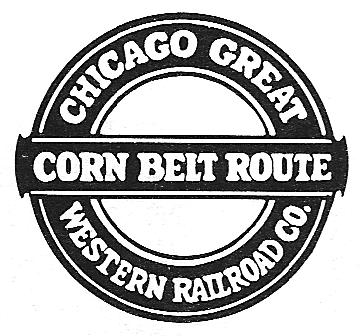 This month’s Classic Trains fallen flag feature is the Chicago Great Western Railroad (CGW) by H. Roger Grant. Not being over-familiar with the US Midwest, while I’d heard of this railway I had no real background knowledge about it. The earliest charter was granted to the Chicago, St. Charles & Mississippi Airline in 1835, but no construction took place under the original management and the charter rights were passed on to the Minnesota and North Western Railroad (M&NW) in 1854. Actual construction of the line did not begin until 1884, connecting St. Paul, Minnesota with Dubuque, Iowa. The M&NW was taken over by the Chicago, St. Paul & Kansas City Railroad under the control of Alpheus Beede Stickney, a St. Paul businessman. By 1892, when the system adopted the Chicago Great Western name, there were routes to Omaha, Nebraska, St. Joseph, Missouri and Chicago.
This month’s Classic Trains fallen flag feature is the Chicago Great Western Railroad (CGW) by H. Roger Grant. Not being over-familiar with the US Midwest, while I’d heard of this railway I had no real background knowledge about it. The earliest charter was granted to the Chicago, St. Charles & Mississippi Airline in 1835, but no construction took place under the original management and the charter rights were passed on to the Minnesota and North Western Railroad (M&NW) in 1854. Actual construction of the line did not begin until 1884, connecting St. Paul, Minnesota with Dubuque, Iowa. The M&NW was taken over by the Chicago, St. Paul & Kansas City Railroad under the control of Alpheus Beede Stickney, a St. Paul businessman. By 1892, when the system adopted the Chicago Great Western name, there were routes to Omaha, Nebraska, St. Joseph, Missouri and Chicago.
The Panic of 1907 ended Stickney’s control of the railway and it ended up in the hands of J.P. Morgan:
Even though Stickney had imaginatively assembled a Midwestern trunk line, he ultimately lost his railroad. The brief but severe Bankers’ Panic of 1907 threw CGW into receivership, a fate the company had avoided during the much more severe Panic of 1893. The nation’s financial wizard, J.P. Morgan, took control, and in 1909 a reorganized Chicago Great Western Railroad made its debut. Morgan wisely placed Samuel Morse Felton in charge, because the new president excelled as a railroad manager. His greatest triumph before joining the Great Western had been to turn the Chicago & Alton into a profitable property.
[…]
The Felton years in Chicago Great Western railroad history resulted in a rehabilitated physical plant. Changes in rolling stock caught the attention of thousands of on-line residents. In 1910, for example, CGW purchased 10 Baldwin 2-6-6-2 Mallets (“Snakes”, as employees called them), and the road’s own shop forces at Oelwein, Iowa, rebuilt three F-3 class 2-6-2s (CGW had 95 total Prairie types) into three more 2-6-6-2s. Unfortunately, these giants did not work out, and in 1916 the Baldwins were sold to the Clinchfield and the homebuilds were rebuilt into 4-6-2s. In the Mallets’ place appeared reliable yet powerful 2-8-2s, of which CGW owned 35.
The railroad became a leader in the use of gasoline and later diesel motive power. Before World War I CGW assembled a small fleet of McKeen motor cars, knife-nosed “wind-splitters” that replaced steam-powered branchline and local trains. Its 1924 gas-electric car M-300 was the first unit of any type sold by the Electro-Motive Co., and it helped replace steam on trains 3 and 4 on the 509-mile Chicago–Omaha run. In 1929 CGW remodeled three McKeens to make up a deluxe gas-electric train, the Minneapolis–Rochester (Minn.) Blue Bird. CGW was mostly satisfied with its pioneering internal-combustion equipment.
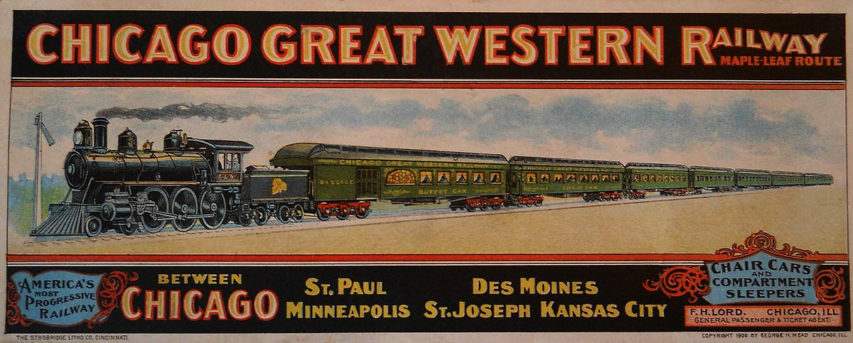
1906 advertising blotter for the Chicago Great Western Railroad’s passenger trains.
Wikimedia Commons.
CGW’s independent life came to an end in the same era as a lot of small to medium sized railways disappeared into corporate mergers, take-overs, or bankruptcy:
Being a small road in an era when competitors were expanding through mergers led to the corporate demise of the CGW. Saying that shareholders “must be protected”, the board sought a partner. Although the expectation was union with KCS or perhaps the Soo Line, the aggressive Chicago & North Western, headed by resourceful Ben W. Heineman, made an acceptable proposal, and in 1968 Chicago Great Western Railroad history ended with it becoming a Fallen Flag.
C&NW operated CGW switchers and F units for a short time, and assimilated Great Western’s only second generation diesels — eight GP30s and nine SD40s, all painted in the final solid “Deramus red” seen also on KCS and Katy — into the yellow fleet.
Although for a short time much of the former Great Western maintained its identity as C&NW’s Missouri Division, that operating organization ended and its lines started to disappear. By the 1980s much of the trackage had been retired, and at the start of the 21st century only about 145 miles remained. Survivors include portions of the main lines in Iowa (Mason City to the Fort Dodge area; Oelwein–Waterloo; and a leg into Council Bluffs); the Cannon Falls (Minn.) branch; and terminal trackage around South St. Paul, Minn., and just west of Chicago.
November 4, 2021
Fallen Flag — the Milwaukee Road
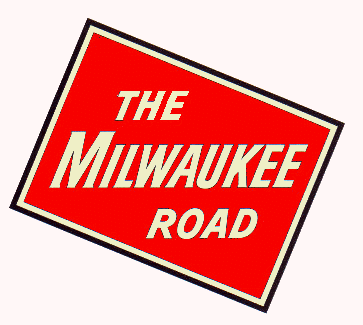 This month’s Classic Trains fallen flag feature is the Milwaukee Road (MILW) by George Drury. As with most major US railways, the Milwaukee Road was a long-term collection of different railway lines, some merged for obvious economic benefit and others taken over to reduce competition, but the first of the components that eventually evolved into the Milwaukee Road system was the 1847 Milwaukee and Waukesha Railroad. This line was incorporated to connect the Wisconsin city of Milwaukee to the river traffic along the Mississippi River, and the corporate name was changed even before construction began to the Milwaukee and Mississippi Railroad to more adequately convey the purpose of the line. The first segment opened in November 1850 connecting Milwaukee and Wauwatosa, a distance of five miles, then to Waukesha a few months later, then to Madison, but not extending all the way to the river at Prairie du Chien until 1857.
This month’s Classic Trains fallen flag feature is the Milwaukee Road (MILW) by George Drury. As with most major US railways, the Milwaukee Road was a long-term collection of different railway lines, some merged for obvious economic benefit and others taken over to reduce competition, but the first of the components that eventually evolved into the Milwaukee Road system was the 1847 Milwaukee and Waukesha Railroad. This line was incorporated to connect the Wisconsin city of Milwaukee to the river traffic along the Mississippi River, and the corporate name was changed even before construction began to the Milwaukee and Mississippi Railroad to more adequately convey the purpose of the line. The first segment opened in November 1850 connecting Milwaukee and Wauwatosa, a distance of five miles, then to Waukesha a few months later, then to Madison, but not extending all the way to the river at Prairie du Chien until 1857.
In that year, another of the frequent financial crises of the era struck and the company struggled on for two years, but eventually went into receivership in 1859. New owner the Milwaukee and Prairie du Chien Railroad took possession in 1861. After the Civil War, the company was merged with the Milwaukee and St. Paul and in 1874 the combined railroad became known as the Chicago, Milwaukee and St. Paul with the completion of a new line connecting with Chicago.
In the next few years the road built or bought lines from Racine, Wis., to Moline, Ill.; from Chicago to Savanna, Ill., and two lines west across southern Minnesota. The road reached Council Bluffs, Iowa, across the Missouri River from Omaha, in 1882, and reached Kansas City in 1887. In 1893 the CM&StP acquired the Milwaukee & Northern, which reached from Milwaukee into Michigan’s upper peninsula.
In 1900 the Chicago, Milwaukee & St. Paul was considered one of the most prosperous, progressive, and enterprising railroads in the U.S. Its lines reached from Chicago to Minneapolis, Omaha, and Kansas City. Secondary lines and branches covered most of the area between the Omaha and Minneapolis lines in Wisconsin, Iowa, and Minnesota. Lines covered much of eastern South Dakota and reached the Missouri River at three places in that state: Running Water, Chamberlain, and Evarts. Except for the last few miles into Kansas City and operation over Union Pacific rails from Council Bluffs to Omaha, the Missouri River formed the western boundary of the CM&StP. (“Milwaukee Road” as a name or nickname did not come into use until the late 1920s; “St. Paul Road” was sometimes used as a nickname, but the railroad’s advertising used the full name).
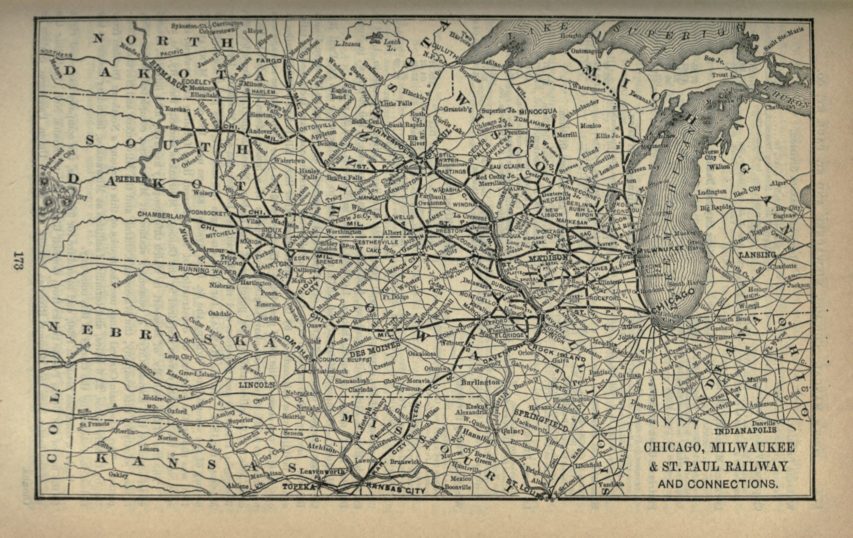
The Chicago, Milwaukee and St. Paul Railway in 1893.
Poor’s Manual of the Railroads of the United States via Wikimedia Commons.
The battle over control of the Northern Pacific and the Burlington in 1901 made the Milwaukee Road aware that without its own route to the Pacific it would be at its competitors’ mercy. At the same time the Milwaukee Road was experiencing a change in its traffic from dominance by wheat to a more balanced mix of agricultural and industrial products. Arguments against extension westward included the possibility of the construction of the Panama Canal and the presence of strong competing railroads: Union Pacific, Northern Pacific, and Great Northern. Arguments for the extension banked heavily on the growth of traffic to and from the Pacific Northwest.
In 1901 the president of the Milwaukee Road dispatched an engineer west to estimate the cost of duplicating Northern Pacific’s line. His figure was $45 million. Such an expenditure required considerable thought; not until November 1905 did Milwaukee’s board of directors authorize construction of a line west to Tacoma and Seattle.
In 1905 and ’06 the Milwaukee Road incorporated subsidiaries in South Dakota, Montana, Idaho, and Washington. The Washington company was renamed the Chicago, Milwaukee & Puget Sound Railway, and it took over the other three companies in 1908. It was absorbed by the CM&StP in 1912.
The extension began with a bridge across the Missouri River at Mobridge, 3 miles upstream from Evarts, S.D. Roadbed and rails pushed out from several points into unpopulated territory. The work went quickly, and the road was open to Butte, Mont., in August 1908.
Unfortunately for the Milwaukee, the Pacific extension was much more expensive to build than the initial estimates (it jumped from $45 million in the 1901 survey to $60 million in 1905), eventually weighing down the company books with $257 million in debt and worse, the traffic estimates for the new line turned out to be wildly optimistic. The difficulties of operating steam locomotives across the extension in winter pushed the railway toward electrification as an efficiency and cost-saving move. Beginning in 1914, sections of the line were converted to overhead catenary power until a total of 645 route-miles were being operated with electric locomotives, reportedly saving the company over a million dollars per year.

A Milwaukee “Little Joe” electric locomotive hauling a freight train along the Pacific extension in 1941. The “Little Joe” locomotives were originally built for the Soviet Union in the late 1940s but the US government cancelled the export license as relations with the Soviets deteriorated and the Cold War escalated. The Milwaukee Road bought 12 of the 20 from General Electric for $1 million during the Korean War.
Wikimedia Commons.
Despite the savings through electrification, the Pacific extension drove the company into bankruptcy in 1925, re-emerging as the Chicago, Milwaukee, St. Paul and Pacific Railroad, but the new company also had to declare bankruptcy during the Great Depression. Trustees ran the railroad for ten years until renewed civilian traffic after World War 2 allowed normal operations to resume. As with most North American railroads, the good times didn’t last and by the late 1950s, the Milwaukee’s management were looking for a merger partner to help cut costs and shed unprofitable branch lines. Unlike the rival merger of of Northern Pacific, Great Northern, Burlington Route, and the Spokane, Portland and Seattle Railway into Burlington Northern, the ICC blocked a merger between the Milwaukee Road and the Chicago and North Western. The ICC also blocked a later application for the Milwaukee to be included in the Union Pacific/Rock Island merger.
With declining business, deferred maintenance issues on most lines, and some self-induced financial issues caused by selling off rolling stock and leasing it back (which exacerbated car shortages leading to further reductions in business), the company had no funds to replace the failing “Little Joe” locomotives on the Pacific extension, so electrification was abandoned in 1974. George Drury sums up the mistakes that led to the end:
Over the decades, the road’s management had made too many wrong decisions: building the Pacific Extension, not electrifying between the two electrified portions, purchasing the line into Indiana, and in the 1960s choosing Flexivans (containers with separate wheels/bogies that required special flatcars) instead of conventional piggyback trailers.
After several money-losing years in the early 1970s, the Milwaukee voluntarily entered reorganization once again on December 19, 1977. The major result of the 1977 reorganization was the amputation of everything west of Miles City, Mont., to concentrate on what became known as the “Milwaukee II” system linking Chicago, Kansas City, Minneapolis-St. Paul, Duluth (on Burlington Northern rails from St. Paul), and Louisville (but no longer Omaha).
By 1983 the Milwaukee’s system consisted of the Chicago–Twin Cities main line; Chicago–Savanna–Kansas City; Chicago–Louisville (almost entirely on Conrail and Seaboard System rails), Milwaukee–Green Bay; New Lisbon–Tomahawk, Wis.; Savanna–La Crosse, along the west bank of the Mississippi; Marquette to Sheldon, Iowa, and Jackson, Minn.; Austin, Minn.–St. Paul; and St. Paul–Ortonville, Minn., plus a few branches.
Three roads vied for what remained of the Milwaukee: the Chicago & North Western, financially none too solid itself; Canadian National subsidiary Grand Trunk Western, with an eye toward creating a route between eastern and western Canada south of the Great Lakes; and Canadian Pacific subsidiary Soo Line.
October 28, 2021
Identifying victims over 40 years later
In Wednesday’s NP Platformed newsletter, Colby Cosh goes back in time to a very different era: the 1970s, when they still hadn’t formally defined the term “serial killer”.
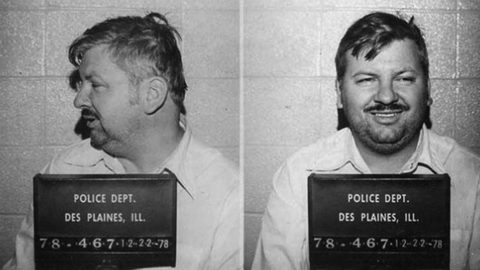
Des Plaines Police Department mugshots of John Wayne Gacy, 22 December, 1978.
Photo via Wikimedia Commons.
The 1970s are another country, and it is the one your correspondent comes from. We have always been interested in the unidentified victims of John Wayne Gacy because it shows just how distant that country really is, even though it seems, in memory, close enough to touch. People who know Gacy as merely the killer clown may not understand how unbelievable the details are when viewed from 2021.
In 1968, Gacy was actually convicted of raping a 15-year-old boy in Iowa and served 18 months in prison. There were sexual assault complaints against him in Chicago — where he had been sent on probation — beginning in 1971. And when he told his surviving victims that the police wouldn’t believe them, he knew what he was talking about, having become respectable enough to be an honorary police precinct captain. One rape-murder victim whose family was searching for him found that he had done work for Gacy, who simply told them the boy had “run away from home”. In other case, a missing boy’s car was found at Gacy’s house. Gacy just admitted to having bought it from the kid, and the trail ran cold.
About half of Gacy’s victims were minors. In a modern city, you couldn’t have more than a few young people vanish from the street or the bus station without the cops realizing they had an enormous investigative problem. But in the ’70s, there was no awareness of anyone “vanishing” at all. Teenagers really were running away from home in simply inconceivable quantities, bouncing around from city to city, and picking up odd jobs like the ones Gacy offered. In the social environment then existing, parents often just accepted the disappearance of children. And runaways still happen, obviously, but now if some 16-year-old stays out too late and doesn’t call home, there’s an official bulletin on Twitter within a few hours.
Police forces still had not quite formulated the concept of a “serial killer”. Gacy’s luck running out was a major reason this finally happened. He was caught only because someone had seen him speaking with a 15-year-old later reported missing; a local cop happened to have a child who was a high school classmate of Gacy’s last victim, and he did extra legwork that nobody had bothered with, finding out about Gacy’s old sodomy conviction.
The minds of professional crime investigators simply did not have room to accommodate the idea of Gacy — or the dozens more like him who began to turn up in the ’80s. NP Platformed is the first to bewail a world of “helicopter parenting” that is creating stunted, fragile adults; but sometimes we remember the fractured, strange, disorderly post-’60s society from which we ourselves came, and we shudder.
July 8, 2021
Fallen Flag — the Illinois Central Railroad
The IC (nicknamed the “Main Line of Mid-America”) was originally incorporated in 1836 to build a rail connection from Cairo to Galena with a branch to Chicago, but didn’t receive federal support until 1850 and the company was finally granted a charter in 1851. The IC was the first “land grant” railroad in the United States, and prominent Illinois politicians were deeply involved in the railroad (Senator Stephen Douglas and future President Abraham Lincoln). The line was completed in 1856 and the “branch” to Chicago rapidly became the busiest portion of the line. After the Civil War, the IC expanded out of Illinois into Iowa and then by acquisition and consolidation eventually reached Louisville, Kentucky and New Orleans, Louisiana with many branches and secondary lines throughout the eastern half of the Mississippi valley. In the 1880s, the IC also expanded north and west, reaching locations in Wisconsin, South Dakota, and Nebraska by the end of the century.
During the 1880s, the IC came under the control of E.H. Harriman and as a result were one of the railroads that were involved in the union actions that ran from 1911 until 1915. The IC and the other Harriman-controlled railways had existing contracts with the individual trade unions representing workers on each line, but the unions hoped to force the railways to recognize a “System Federation” of the separate unions that would negotiate as a single unit. The IC refused and hired strikebreakers to fill the positions vacated by striking union members — including many African-American men who would not normally have been allowed to work in those positions on southern railways. Sporadic violence in 1911 and 1912 resulted in the deaths of at least 12 men and 30 others were killed in a steam locomotive boiler explosion in San Antonio, Texas. It was generally seen as a failure by mid-1912, but the strike didn’t formally end until 1915. The unions tried again in 1922 in the Great Railroad Strike, which was an even larger attempt by the unions to operate as a single bargaining unit, and another ten people were killed during the conflict but it lasted only a couple of months and failed to achieve its aims.
Although the major portions of the system were in place by World War 1, there were some additional lines added through to the 1960s, merging or acquiring control of lines like the Yazoo & Mississippi Valley, the Gulf & Ship Island, the Chicago, St. Louis & New Orleans, the Alabama & Vicksburg, and the Vicksburg, Shreveport & Pacific. George Drury picks up the story in mid-century:
In the 1950s and early ’60s IC purchased several short lines: former interurban Waterloo, Cedar Falls & Northern (jointly with the Rock Island through a new subsidiary, Waterloo Railroad); Tremont & Gulf in Louisiana; Peabody Short Line, a coal-hauler at East St. Louis, Ill.; and Louisiana Midland.
In 1968 Illinois Central acquired the western third — Nashville to Hopkinsville, Ky. — of the Tennessee Central when that financially ailing line was split among IC, Louisville & Nashville, and Southern.
Illinois Central Gulf
Illinois Central and parallel Gulf, Mobile & Ohio merged on August 10, 1972, to create the Illinois Central Gulf Railroad, a wholly owned subsidiary of Illinois Central Industries. GM&O was a likely merger partner for Illinois Central, as it was a north-south railroad through much the same area as IC. As part of the merger, ICG took over three Mississippi lines: Bonhomie & Hattiesburg Southern; Columbus & Greenville; and Fernwood, Columbia & Gulf.
The north-south lines of ICG’s map resembled an hourglass. Driving across Mississippi or Illinois from east to west, you could encounter as many as eight ICG lines. The former IC system converged at Fulton, Ky., and the former GM&O main line was less than 10 miles west of Fulton at Cayce.
[…]
On Feb. 29, 1988, the railroad changed its name back to Illinois Central, having divested itself of nearly all the former GM&O routes it acquired in 1972, when it added “Gulf” to its name. At the end of 1988 the Whitman Corp. (formerly IC Industries) spun off the railroad, which then dropped “Gulf” from the name, and in August 1989 control of the railroad was gained by the Prospect Group, which formerly controlled spinoff MidSouth Rail.
IC managers eventually turned their eyes west, to the Chicago, Central & Pacific, which it had sold in 1985. It saw CC&P’s route as a source of grain traffic and perhaps a way to get some of the coal moving east from Wyoming. In June 1996 IC purchased the CC&P. The line remains active.
In February 1998 Canadian National Railway agreed to purchase the IC, creating a 19,000-mile railroad. CN absorbed IC in July 1999, and IC lost its own identity within the CN system.
October 23, 2017
It’s legal to sell 2×4 lumber that’s not actually 2″ by 4″
Not only is it legal, that’s the way construction lumber has been marketed and sold for decades. A recent Illinois case against US DIY chain Menards was dismissed recently:
A federal judge has slammed the door on the Illinois lumber shoppers who sued Menards claiming it deceived them about the size of its 4x4s.
Saying no reasonable consumer would regard Menards’ descriptions of its lumber the way plaintiffs Michael Fuchs and Vladislav Krasilnikov said they did, the judge last week dismissed the would-be class action lawsuit against the Wisconsin-based home-improvement chain.
The decision by U.S. District Judge Edmond Chang throws out a case in which Menards was accused of deception because it marketed and labeled its 4x4s without specifying that the boards measure 3½ by 3 ½ inches.
So-called dimensional lumber — 2x4s, 4x4s, 2x6s and such — is commonly sold by names that do not specify the measurements of the pieces. The longstanding industry convention is recognized by the U.S. Department of Commerce, which distinguishes between the “nominal” designations for pieces of lumber and their actual size. The department says a 2×4, for example, can measure 1½ inches thick by 3½ inches wide.
The distinction between the name and the actual dimensions stems from the fact that lumber, when it is produced, typically is trimmed to smooth it after the initial rough cut, Chang said in his decision.
July 20, 2017
Words & Numbers: The Illinois Budget is a Mess
Published on 19 Jul 2017
This week on Words & Numbers, Antony Davies and James R. Harrigan tackle the disaster that is the Illinois state budget crisis.
Pro-tip: Don’t let it happen to your state.
January 24, 2017
QotD: Token ownership to game government mandates
I was researching energy shorts and had a ton of discussions with former regulatory types in the U.S. I was stunned to discover that there was widespread acknowledgement on the regulatory side that many regulations were impossible to comply with and so “compliance trump cards” were built into the system.
For instance, in Illinois you get favorable treatment as a potential government contractor if you “comply” with all sorts of insane progressive policy strictures. “Woman or minority owned business” or “small business owner”, as an example. Even a small advantage in the contracting process for (for example) the State of Illinois puts you over the edge. Competitors without (for instance) the Woman or Minority Owned Business certification would have to underbid a certified applicant by 10-15% (it’s all a complex points system) to just break even. It got so bad so quickly that the regs were revised to permit a de minimis ownership (1%). Of course, several regulatory lawyers quickly made a business out of offering minority or women equity “owners” who would take 1% for a fee (just absorb how backwards it is to be paying a fee to have a 1% equity partner) with very restrictive shareholder agreements. Then it became obvious that you’d get points for the “women” and “minority” categories BOTH if you had a black woman as a proxy 1% “owner.” There was one woman who was a 1% owner of 320 firms.
The proprietor of the Finem Respice blog, quoted by Warren Meyer, “Diesel Emissions Cheating, Regulation, and the Crony State”, Coyote Blog, 2017-01-14.
January 7, 2016
QotD: The right to record police officers
Some advice for the beleaguered and backward states of Illinois, Massachusetts, et al.: If police are not obliged to ask our permission before recording their public encounters with us, then we should not be obliged to ask their permission before recording our public encounters with them. That states generally dominated by so-called progressives should be so insistent upon asymmetric police powers and special privileges for government’s armed agents is surprising only to those who do not understand the basic but seldom-spoken truth about progressivism: The welfare state is the police state.
Why Illinois Republicans are on board is another matter, bringing up the eternal question that conservatives can expect to be revisiting frequently after January: What, exactly, is the point of the Republican party?
Illinois is attempting to resurrect what the state’s politicians pretend is a privacy-protecting anti-surveillance law; in reality, it is the nearly identical reincarnation of the state’s earlier anti-recording law, the main purpose of which was to charge people who record police encounters with a felony, an obvious and heavy-handed means of discouraging such recording. Illinois’s state supreme court threw the law out on the grounds that police do not have a reasonable expectation of privacy when carrying out their duties, though police and politicians argued the contrary — apparently, some part of the meaning of the phrase “public servants” eludes them. The new/old law is, by design, maddeningly vague, and will leave Illinois residents unsure of which encounters may be legally recorded and which may not.
Here is the solution: Pass a law explicitly recognizing the right of citizens to record police officers. It is important to note that such a law would recognize a right rather than create one: Government has no legitimate power to forbid free people from using cameras, audio-recording devices, or telephones in public to document the business of government employees. The statute would only clarify that Americans — even in Illinois — already are entitled to that right.
Kevin D. Williamson, “Prairie State Police State”, National Review, 2014-12-10.
February 9, 2015
Accused “SWATter” arrested in Las Vegas
In the Chicago Sun-Times, LeeAnn Shelton reports on an arrest in Las Vegas for computer-related crimes and (effectively) attempted murder by falsely reporting a serious crime at another address to get the SWAT team to raid that location.
A gamer known online as “Famed God” — who made up a murder to get police to go to an unsuspecting west suburban resident’s home last year — is behind bars in Nevada awaiting extradition.
Brandon Willson, 19, was arrested Thursday after authorities searched his home in the 4600 block of El Presidente Drive in Las Vegas, a statement from the Will County state’s attorney’s office said.
Willson used a computer to contact Naperville’s 911 center on July 10, 2014, and claimed a murder had happened at a home in the city, prosecutors claim. Naperville’s Special Response Team responded but found no crime.
The practice involves someone falsely reporting a dangerous situation to send police to another person’s home. It is known as “swatting” because the hoax calls can lead to deployment of SWAT teams.
Calling it a “dangerous prank,” State’s Attorney James Glasgow plans to craft legislation that would make swatting a felony in Illinois, the statement said. The bill would also require anyone convicted of swatting to reimburse municipalities for the cost of the emergency response.
April 27, 2014
Gerrymandering
Former US Supreme Court Justice John Paul Stevens has published a book in which he calls for certain amendments to the constitution, one of which is quite appealing:
1. Requiring that congressional and state legislative districts be “compact and composed of contiguous territory” to stop both parties from carving out safe seats.
US electoral districts can be particularly odd creatures. In a post from 2010, Zombie looks at the “top ten” gerrymandered districts … and they’re hard to believe. Here’s North Carolina-12, number 10 on the list:
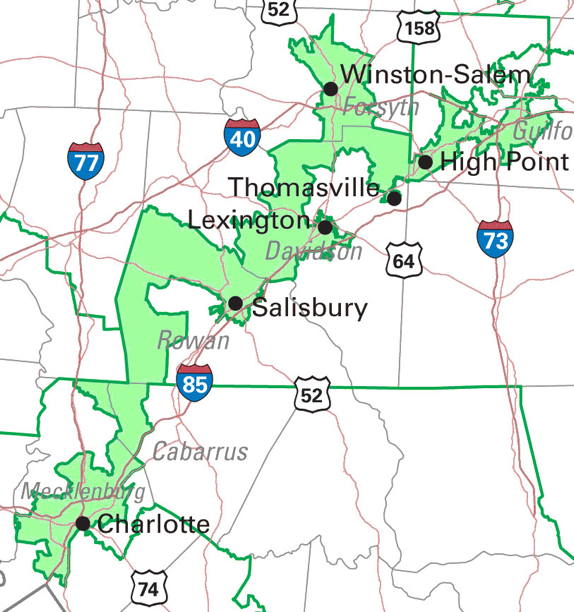
This is what most people imagine when they think of a gerrymandered district — what I call “Gerrymander Classic.” NC-12 looks very much like the gerrymandered districts of the 19th century, but taken to extremes. As bad as it is, NC-12 at least looks like a congressional district, with meandering lines, consistent width, and hand-drawn appearance. As we’ll soon see, modern gerrymandering is often another animal altogether, with jarring shapes and artificial boundaries that are not just offensive to the eye but somehow feel like an insult to rationality.
Coming in at number 5, it’s Illinois-17:
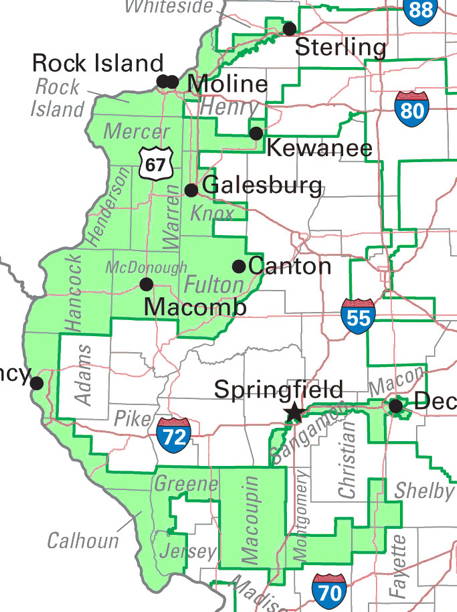
Political scientists love to cite IL-17 as the prototypical gerrymandered district, and you are likely to see IL-17 used as the illustration in many academic treatises about redistricting. And we can see why here. Its shape has often been described as “a rabbit on a skateboard,” though to me it looks more like an embryonic ichneumon wasp with a pancreatic cyst. We saw above how PA-12 was a gerrymandering blunder by the Republicans; IL-17 is the opposite, a gerrymandered district created by Democrats to ensure themselves a seat in western Illinois — but which this year was snatched from their grasp by Tea Party candidate and now congressman-elect Bobby Schilling. Ooops! The Democrats went out on a limb when drawing IL-17 — several limbs, by the looks of it — but the wave election of 2010 changed the electoral landscape. Let me repeat my warning to over-confident redistricters next year: THINGS CHANGE. Gerrymander at your own risk.
And finally, the circa 2010 winner of the most gerrymandered district in the United States award, Illinois-4:
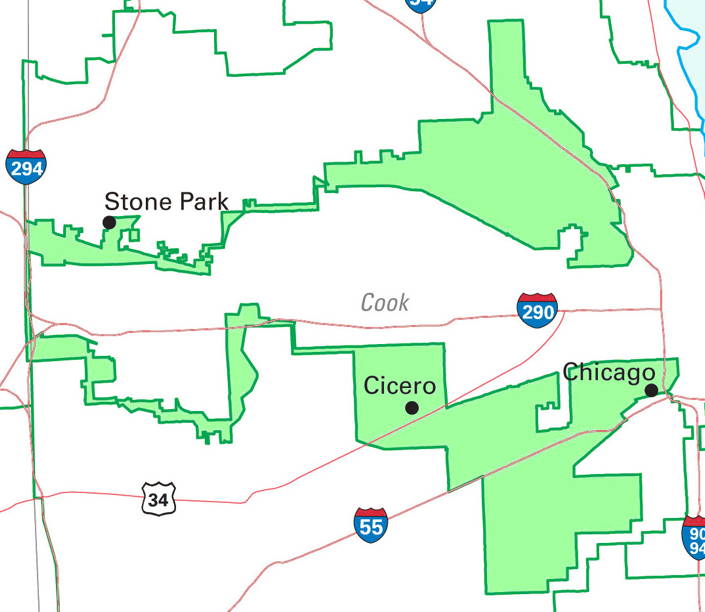
Here it is: The most ridiculous congressional district in the entire country. No, you’re not looking at two districts; IL-4 has two absurdly gerrymandered halves held together by a thin strip of land at its western edge that is nothing more than the median strip along Interstate Highway 294. The end result is a gerrymandered gerrymander, a complete mockery of what congressional representation is even supposed to be. As with AZ-2, the intention behind IL-4 was to create an ethnic enclave, in this case an Hispanic-majority district within an otherwise overwhelmingly non-Hispanic Chicago. Problem is, Chicago has two completely distinct and geographically separate Hispanic neighborhoods — one Puerto Rican, the other Mexican — but neither is large enough to constitute a district majority on its own. Solution? Lump all Hispanics together into a supposedly coherent cultural grouping, and then carefully draw a line surrounding every single Hispanic household in Chicago, linking the two distant neighborhoods by means of an uninhabited highway margin. Voila! One Hispanic congressperson, by design. And as a side-effect, the most preposterous congressional district in the United States.
The kicker? Those ten are at least legal in that they’re contiguous. Zombie goes on to show some even more outrageous examples where that requirement is blatantly ignored.
November 12, 2013
Corruption watch: US government edition
In his weekly NFL column, Gregg Easterbrook frequently has extended discussions of non-football items like this week’s quick tour of recent US federal, state, and local government agencies’ corruption news:
This column contends that corruption in government is a larger problem than commonly understood — that a reason expenditures at the federal, state and local levels keep smashing records, yet schools and bridges don’t get built, is that a significant fraction of what government spends is not just wasted, it is stolen.
Last week’s news that two senior admirals have been placed on leave on suspicion of corruption, while two Navy commanders and a senior official of the actual NCIS, not the TV show, have been arrested and charged with corruption, might be just the tip of an iceberg, to employ a nautical metaphor. Here’s a quick tour of recent corruption charges:
In federal government, a top EPA official stole nearly $900,000 from the agency, including through his expense account and by not reporting to work for months at a time yet receiving full pay. Absurdly, he was believed at the EPA when he claimed to be on assignment for the CIA. If the CIA needed an environmental specialist, there is a system by which one would be “detailed,” and the EPA would know.
Recently, an Army contractor was sentenced to 20 years in prison for stealing about $30 million using false invoices. Former congressman Jesse Jackson Jr. recently was sentenced to prison for embezzling from campaign funds; his wife was sentenced for income-tax evasion. (The campaign embezzlement did not cost taxpayers anything, the tax evasion did.)
In state government, the Securities Exchange Commission has accused the state of Illinois of pension bond fraud. The S.E.C. has charged the former head of the California state pension fund with fraud. Members of the New York Senate have been arrested on bribery charges. The lieutenant governor of Florida resigned over involvement with a fake charity.
In local government, the former mayor of Detroit just went to prison for corruption. Several members of the Washington, D.C., city council have been jailed or indicted for corruption, including one in jail for stealing from a youth-sports fund. A former California mayor just pleaded no contest to corruption charges. A former Chicago alderman just pleaded guilty in a corruption case. Chicago might be “the most corrupt city in the country,” with kickbacks and embezzlement costing Chicago taxpayers $500 million per year, a rate that works to $185 annually stolen from each resident.
[…]
In a big, complicated world, there will always be some who steal. Most public officials are honest and work hard to administer public funds properly. But we tend to think of theft in government as a problem of bygone days of bosses in smoke-filled rooms. With evermore money flowing into government, evermore corruption might be one result.
February 27, 2013
RIP Allan B. Calhamer
The creator of the game Diplomacy died this week:
Allan Calhamer, designer of Dimplomacy – possibly the most perfect boardgame – has passed away. en.wikipedia.org/wiki/Allan_B._… … #fb
— John Kovalic (@muskrat_john) February 27, 2013
I was a big fan of the game for many years, even publishing a play-by-mail “zine”, as I mentioned a couple of months back:
Long ago, in the days before personal computers were ubiquitous, there were “zines” (short for magazines, correctly reflecting both non-professional status and less-than-totally-serious content). There was a wide variety of zines for all sorts of interests — rather like the back corners of the internet today, except they were physically distributed using the post office (and therefore had to stay within certain boundaries to be safe). Clive and I used to publish a zine for postal Diplomacy:
Download PDF
Download PDF
Update: Should have included a hat-tip to John Kovalic, who linked to a highly appropriate Dork Tower strip from last year.
Update, the second: The Chicago Sun-Times obituary:
To people in La Grange Park, Allan B. Calhamer was the guy who delivered the mail.
But to those who have played Diplomacy — the popular board game he invented while a law student at Harvard — Mr. Calhamer, who died Monday, was a geek god.
Back in the Fortran era, the game was a sort of board-game version of TV’s Survivor set in pre-World War I Europe, with its shifting alliances, deception and back-stabbing.
[. . .]
In an article he wrote for diplomacy-archive.com, Mr. Calhamer said the game can “make some people almost euphoric and causes others to shake like a leaf.”
“It’s pitiless because, in the game Diplomacy, there will be one winner,” said game designer Steve Jackson, founder of Steve Jackson Games. “You negotiate, you make deals, you lie.”
Game experts and industry analysts say “Dip” influenced generations of designers.
More than 50 years after Mr. Calhamer invented it, enthusiasts still engage in Diplomacy all-nighters, their long stretches of quiet strategizing punctuated by occasional shouts like: “You gave me your word you would attack Berlin!” And: “My own mother took part of Russia from me!” That’s according to chatter on boardgamegeek.com.
The game is jokingly referred to as a pastime that has been “Destroying Friendships since 1959,” said Mike Webb, vice president of marketing and data services for Alliance Game Distributors.
October 15, 2012
A “violence tax” that would only fall on the non-violent
Steve Chapman on a recent proposal that will penalize the non-violent for violence in their community:
For urban politicians, gun control is like the bar in Cheers — a place of refuge they can seek out whenever things aren’t going well. Things aren’t going well on the crime front in Chicago, with homicides up 25 percent this year. So what else can our elected leaders do but promise action against guns?
Action against the possession and use of guns by violent felons would be a good idea, but the proposal offered by Cook County Board President Toni Preckwinkle is something else: a penalty on nonviolent citizens who bear no blame for the carnage.
Preckwinkle suggested a tax on sales of firearms and ammunition, with the goal of defraying the costs that gunshots create for the county hospital and jail. Her spokesperson couldn’t say what the tax rate would be or how much revenue it would yield but said the fee would be “consistent with our commitment to pursuing violence reduction in the city and in the county.”
[. . .]
The levy was dubbed a “violence tax,” which is exactly what it isn’t. It would not target criminals who have malice in mind, but would fall entirely on the law-abiding.
Anyone convicted of a felony, after all, is ineligible for an Illinois Firearm Owner’s Card, which is legally required to buy guns or bullets. Under federal law, felons are barred from owning guns. So ex-con gang members would not pay the tax, because they make all their purchases in the illegal market. It would hit only those gun owners who have used their firearms responsibly.

